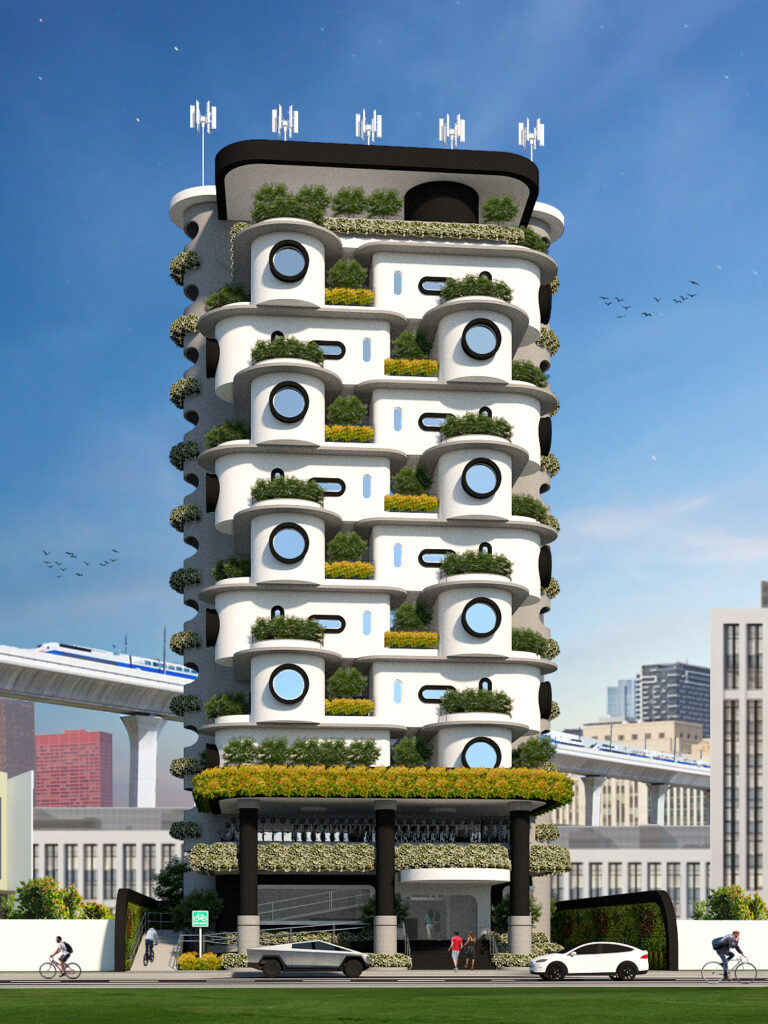
ECO MANILA
Location: MANILA, PHILIPPINES
Floor Area: 3250.00 SQ. M.
The project is located in the city of Manila. Manila is the capital of the Philippines; it is the center of the country’s economic, political, social, and cultural activity. But despite having cultural and historical significance the city is on the brink of destruction because of overpopulation and traffic. It is the most populated city in the world with three million informal settlers in need of good shelter. The city has the worst traffic in Asia because of the large number of private vehicles and poor infrastructure. The aim of the proposed development is to create a sustainable mass housing project and to ease traffic with the aid of sustainable mode of transportation.
The floor plan concept was inspired from the traditional bahay kubo. The project features a multi-functional interior space that can be transformed depending on the need from morning to night time. A single unit can be transformed into eight different uses, from standard living area to dining area, gym, study area, working area, theater room, and bedroom. Some functions can be used at the same time like the living area with kitchen or a bed and kitchen that cater the needs of a family for a regular day. To achieve this multi-functional approach users’ behavior needed to be studied and integrated within the unit and furniture indeed to be specifically designed for the project, the furniture was designed to be user friendly, durable, lightweight, stackable, and can be locked together. It can do many configurations and can be easily rearranged in seconds. The units were designed to accommodate a growing family that lives within the city.
One of the major challenges is to design a building with no parking spaces for cars but for parking bicycles only. Manila has a great traffic problem and requires a great traffic solution to offset decades of traffic. With this approach users can help reduce the number of cars that occupy the roads with a far more sustainable mode of transportation. This approach already worked with few projects around the world, especially with densely populated areas. The project will only work with a good local transportation system. The development hopes that the government will continue to develop its infrastructure to create a much more comfortable transportation and be connected to such development. The project is proposed to be built in nineteen different locations in the city and be built within 400 meters or five minutes’ walk away from the city’s local transportation hubs.
The building breathes – the project features cross-ventilated spaces not only for individual units but for the whole development greatly reducing the need for air conditioning systems to lower the temperature within its premises. Glazing was reduced due to its heat absorbing properties, instead plants were used to absorb heat and cool spaces. The project is a sustainable development with solar panel and wind turbine capable of producing 150,000 watts per day, the project also has a rainwater harvesting system that can store up to 35,000 liters of water.
The project has curvilinear walls with circular windows inspired from a bicycle evoking an idea that it is a cyclist building with greenery visible from in and out. The project features a canopy for each unit to block heat from the sun and barrier against rain. The building was not just inspired from a bicycle but also has bicycle friendly amenities like: parking, cyclist ramp, repair shop, and shower area near the bicycle parking area. The project is also designed to enhance the users’ experiences with each other with community library for knowledge sharing, community workshop for skills sharing, community closet for preloved items sharing, and community pantry for food sharing.
The building is mainly in black and white color scheme to emphasize the people and the greenery present within the structure. The building aims to inspire people to live sustainably and to live in community. The project is not only hoped to be developed in Manila but also to nearby cities that are greatly in need of such development.
